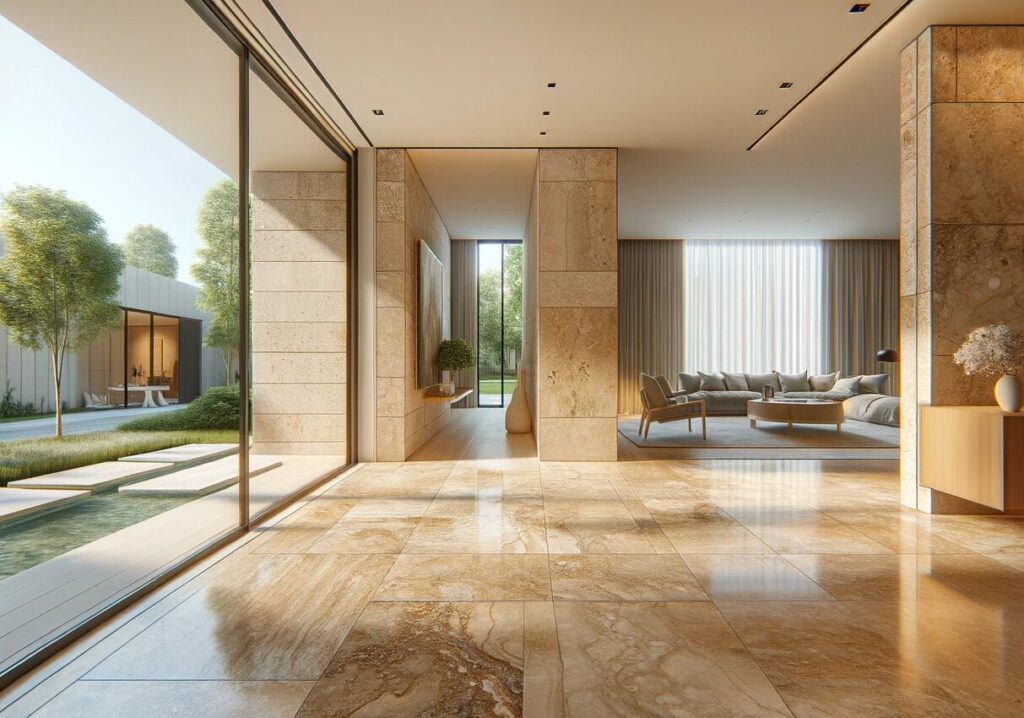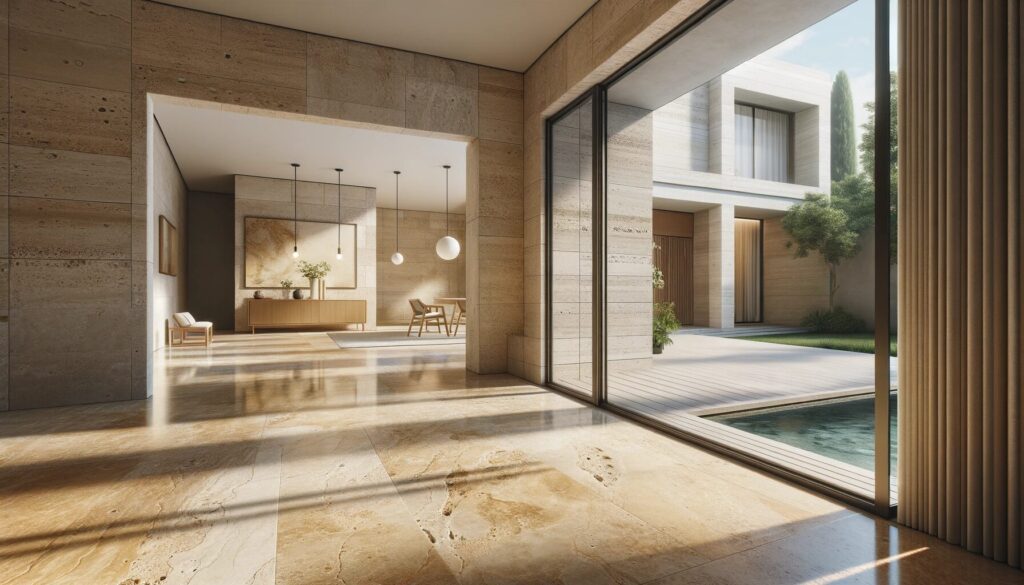Embarking on the journey of choosing the right flooring can be daunting, but let’s delve into the world of travertine, a choice that marries elegance with endurance. This isn’t just a flooring option, it’s a statement of timeless appeal, blending historical significance with contemporary style. Think of travertine as a bridge connecting the architectural grandeur of the past with the sleek, modern designs of today.

What is Travertine?
Travertine is more than just a type of stone, it’s a testament to nature’s artistry. Born from mineral-rich groundwater emerging through hot springs, travertine forms over time into a dense, durable limestone. Each piece is like a fingerprint, unique with its own patterns and colorations, thanks to the various minerals present during its formation.
- Tumbled Travertine: This variety boasts an antiqued, worn look, with rounded edges and a porous surface. It exudes a rustic, welcoming atmosphere, perfect for spaces where you want warmth and character.
- Polished Travertine: Here we find travertine in its most refined form, with a glossy surface that reflects light and adds a touch of sophistication. Ideal for formal settings, polished travertine is as elegant as it is timeless.
- Honed Travertine: Striking a balance between rustic and refined, honed travertine offers a smooth, matte finish. It’s a practical choice for high-traffic areas, gracefully concealing everyday wear and tear.
- Brushed Travertine: With a focus on texture, this type is treated with wire brushes, resulting in a rugged, non-slip surface. It’s an excellent choice for areas like kitchens and bathrooms where slip resistance is a priority.
Advantages of Travertine Flooring
Opting for travertine flooring isn’t just an aesthetic choice, it’s a practical investment in your property. Here’s why:
- Aesthetic Appeal: Travertine brings the beauty of the natural world into your home. Each tile tells a story, with diverse patterns and shades ranging from ivory to deep walnut. It’s an opportunity to create a unique, inviting space.
- Durability and Longevity: Don’t let its beauty fool you, travertine is resilient. It’s capable of enduring the rigors of daily life while retaining its elegance. Properly cared for, travertine floors can last generations.
- Adds Value to Property: Installing travertine is more than a renovation, it’s an investment. This luxurious material not only enhances the beauty of your space but also contributes to the overall value of your property.
Installation of Travertine Floors
When you’re gearing up to lay travertine, you’re not just installing a floor, you’re crafting a centerpiece for your home. It requires a methodical approach, balancing precision with practicality.
Pre-installation Considerations:
- Subfloor Preparation: It’s crucial to start with a solid, level base. Whether concrete or wood, ensure your subfloor is structurally sound and free from moisture issues. An uneven subfloor is the nemesis of tile flooring, leading to potential cracks and instability.
- Climate Considerations: Be mindful of the environment where the travertine will reside. Natural stone responds to environmental changes. In areas with significant temperature fluctuations, allow for expansion by leaving a small gap around the perimeter, covered by base molding.
Step-by-Step Guide:
- Dry Layout: Before committing to adhesive, lay out your tiles. This planning stage helps you visualize the end result, allowing for adjustments in tile placement and cuts.
- Mixing Thinset: Achieving the right consistency in your thinset is akin to baking a perfect cake – it needs to be just right. Aim for a thick, but spreadable consistency.
- Applying Thinset: Use a notched trowel at a 45-degree angle to spread the thinset. Working in small sections prevents the mortar from drying out before the tile is laid.
- Laying the Tiles: Gently place the tiles into the thinset, pressing down with a slight twisting motion. This ensures a solid bond and helps avoid hollow spots beneath the tiles.
- Spacing and Alignment: Consistency is key in tile spacing. Use spacers to maintain even grout lines and ensure your pattern stays true.
- Cutting Tiles: Measure meticulously and use a wet saw for clean cuts. It’s a tool that, when used carefully, can ensure the precision required for a seamless finish.
DIY Tips:
- Protect your knees with quality pads – your future self will thank you.
- A damp sponge is essential for immediately cleaning excess thinset.
- After setting each tile, tap it gently to check for hollow sounds that indicate insufficient thinset.

Maintenance and Care
Daily Cleaning and Care Tips:
- Regular Sweeping: Dirt acts like sandpaper underfoot, so a soft-bristled broom is your first line of defense.
- Mopping: A mop with a pH-neutral cleaner will maintain the stone’s integrity. Avoid acidic cleaners that can etch the surface.
- Immediate Spill Cleanup: Travertine is porous, prompt cleanup prevents stains.
Long-Term Maintenance Strategies:
- Sealing: Regular sealing is like an insurance policy against stains and damage, prolonging the life and beauty of your travertine.
- Deep Cleaning: Occasionally, a deeper clean with a stone-safe cleaner can refresh the surface and grout.
Preventive Measures:
- Implement the use of mats and rugs in high-traffic zones to reduce wear.
- Felt pads on furniture feet can prevent unsightly scratches.
- Be mindful of dragging heavy objects across the floor.
Design Ideas with Travertine Floors
Creative Ways to Incorporate Travertine:
- Varied Patterns: Experiment with different tile patterns like chevron or Versailles to add visual interest.
- Accent Borders: Use darker shades of travertine as a border or accent to define spaces and add an artistic touch.
Combining with Other Materials:
- Travertine and wood create a warm, inviting atmosphere, blending the rustic with the refined.
- Incorporating metals or glass with travertine can yield a sleek, modern aesthetic.
Design Inspirations:
- Traditional Settings: Combine travertine with classic design elements for an old-world charm reminiscent of historic European architecture.
- Modern Spaces: Opt for large-format travertine tiles with minimal grout lines for a clean, contemporary look.
Cost and Budgeting
When embarking on a travertine flooring project, understanding and planning your budget is crucial. Let’s dissect the costs and see how it stacks up against other options.
Breakdown of Travertine Flooring Costs:
- Materials: The cost of travertine tiles varies, generally ranging between $5 to $30 per square foot. The variation in price is often due to the tile’s quality, finish, and rarity.
- Installation: For those who aren’t taking the DIY route, installation costs are an additional factor. Depending on your region and the expertise of the installer, this could add $3 to $7 per square foot.
Comparisons with Other Flooring Options:
- When compared to ceramic or porcelain, travertine is typically pricier, thanks to its natural stone quality. However, it’s often more affordable than marble while offering a similar upscale appearance.
- It’s important to factor in the longevity and aesthetic value of travertine when comparing costs. Its durability can make it a more cost-effective choice over time.
Budgeting Tips for Homeowners and Contractors:
- Shop Around: Don’t settle on the first price you find. Explore different suppliers to find the best deal.
- Plan for the Extras: Remember, your budget should include not just the tiles but also the underlayment, grout, sealant, and any tools you might need.
- Consider the Long-Term: Travertine is an investment. Its durability and timeless appeal can offset the initial cost over the years.
Common Challenges and Solutions
Travertine, like any natural stone, comes with its own set of challenges. Here’s how to address them effectively.
Staining, Chipping, and Cracking:
- Staining: Prevention is key. Sealing the travertine can protect it from spills. For existing stains, a stone poultice can be effective.
- Chipping and Cracking: Be careful during installation to avoid damage. For minor chips, a color-matched epoxy or filler can work. For larger cracks, consulting a professional may be necessary.
- Etching: Acidic substances can mar travertine. Avoid using vinegar or citrus-based cleaners and consider polishing affected areas to restore the surface.
Professional Repair Techniques and DIY Fixes:
- Regular maintenance, including sealing and gentle cleaning, can prevent many issues.
- For DIY repairs, use stone repair kits to address small chips and cracks.
FAQ Section
Travertine is surprisingly adaptable to different climates. It can withstand temperature changes, but it’s important to consider proper installation techniques to allow for natural expansion and contraction.
Yes, travertine is a robust material suitable for high-traffic areas. With the right installation and regular maintenance, it can withstand heavy use while maintaining its beauty.
For routine cleaning, use a soft mop with a pH-neutral cleaner. Abrasive or acidic cleaners should be avoided to prevent damage to the stone. Regular sweeping or dry mopping can also help maintain the stone’s appearance.
Generally, resealing should be done every 3 to 5 years, but it can vary based on the level of foot traffic and the location of the flooring. High-traffic areas may require more frequent sealing.
Travertine can be a pet-friendly flooring option. However, it’s important to keep pets’ nails trimmed to avoid scratches and clean up any accidents quickly to prevent staining.
Travertine can be installed over radiant heating systems. It conducts heat effectively, making it a comfortable choice for such installations. Ensure that the heating system is compatible with natural stone flooring.
